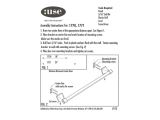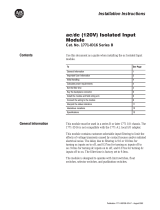Page is loading ...

Looking for more information?
Visit
us
on the
web
at http://www.artisan-scientific.com for more information:
•
Price
Quotations •
Drivers·
Technical
Specifications.
Manuals and Documentation
Artisan
Scientific
is
You~
Source
for:
Quality
New
and
Certified-Used/Pre:-awned ECJuiflment
•
Tens
of
Thousands
of
In-Stock
Items
•
Hundreds
of
Manufacturers
Supported
•
Fast
Shipping and
DelIve1y
•
Leasing
/ Monthly
Rentals
• Equipment Demos
•
Consignment
Service Center Repairs
Experienced Engineers and Technicians
on
staff
in
our
State-of-the-art Full-Service In-House Service Center Facility
InstraView Remote Inspection
Remotely inspect equipment before purchasing with
our
Innovative InstraView-website at http://www.instraview.com
We
bUy
used
equipment!
We
also
offer
credit
for
Buy-Backs
and
Trade-Ins
Sell
your
excess.
underutilized. and idle used equipment. Contact one
of
our
Customer
Service
Representatives todayl
Talk to a live person: 88EM38-S0URCE fB88-887-68721 I Contact
us
by
email: [email protected] I Visit ourwebsite: http://www.artisan-scientific.com

Selectable Contact Output Module
Cat. No. 1771–OW
This document provides information on:
• important pre–installation considerations
• power supply requirements
• installing the module
• connecting the wiring
• using the indicators on the module for troubleshooting
• module specifications
These modules do not contain surge limiting circuitry. Use these
modules for switching resistive loads only. They are not
recommended for inductive or capacitive loads.
The outputs are arranged in 4 groups of 2, each group with its own
common. Each output is electrically isolated from module logic
circuitry. The module can simultaneously switch all 8 outputs to
separate loads, each conducting a maximum load of 1.0A
continuously, at rated power. Ac loads switched by the modules
should have a power factor (PF) of 1.0.
Maximum interconnect cable length for these modules is 1000 ft.
(304.8 meters).
The controller or I/O chassis power supply, connected through the
backplane of the I/O chassis, powers the logic circuitry of the contact
output modules. This supply also provides the necessary power to
energize the coils of the module relays. The maximum current drawn
from this supply when all coils are energized is 700mA.
In this section we tell you how to initially handle your module, key
your I/O chassis, set the relay output jumpers, install your module
and make your wiring connections.
Installation Instructions
To The Installer
Pre–installation
Considerations
Power Supply
Requirements
Installing Your Module

Selectable Contact Output Module2
Publication
1771-2.1
10 – December 1989
Initial Handling Procedures
ATTENTION: Remove power from the 1771 I/O
chassis backplane and wiring arm before removing or
installing an I/O module.
• Failure to remove power from the backplane or wir-
ing arm could cause module damage, degradation of
performance, or injury.
• Failure to remove power from the backplane could
cause injury or equipment damage due to possible
unexpected operation.
The contact output module contains components which can be
damaged by electrostatic discharge. The module is shipped in an
electrostatic shielded bag for protection. Follow the handling
procedures outlined below to guard against damage to your module.
• Touch a grounded object to discharge yourself before handling
the module.
• Do not touch the backplane connector or connector pins.
• If you configure or replace internal components, do not touch
other circuit components inside the module. If available, use a
static–safe work station.
• When not in use, keep the module in its static–free shield bag.
Keying the I/O Chassis
Use the plastic keying bands, shipped with each I/O chassis, to key
your I/O slots to accept only this type of module. Place the keying
bands on the chassis backplane between:
• 6 and 8
• 16 and 18
Slots on the rear edge of the circuit board are matched to these slots
to allow insertion of this type of module. You can key any connector
in an I/O chassis to receive this module except for the leftmost
connector reserved for adapter or processor modules.
Setting the Relay Output Jumpers
When the output image table bit at the address corresponding to any
output is energized (set to 1), the corresponding relay contact is
closed or opened, respective to the jumper setting.

3
Selectable Contact Output Module
Publication
1771-2.1
10 – December 1989
All outputs are individually selectable for either normally–open or
normally–closed operation. They are pre–set for normally–open
operation at the factory. To reset any jumper, proceed as follows:
1. Remove the 4 screws from the side cover and separate the circuit
board from the 2 covers.
2. Move the jumper to the desired position (see below). Jumpers are
identified by jumper number and use (N.O. or N.C.).
3. Reinstall the circuit board in the module and replace the cover.
Figure 1
Relay
Output Jumper Setting
N.O.1
N.C.1
N.O.1
N.C.1
Normally Open
Normally Closed
Printed Circuit Board
K1
K2
K3
K4
N.O.1
N.O.2
N.O.3
N.O.4
N.C.1
N.C.2
N.C.3
N.C.4
11928–I
Inserting the Module Into the Chassis
1. Position the module so that the circuit board on the rear of the
module lines up with the top and bottom card guides in the
chassis.
2. Slide the module into the chassis.
3. Press firmly to seat the module in the chassis backplane
connector.
4. Swing the module locking latch down into place over the front
edge of the module.

Selectable Contact Output Module4
Publication
1771-2.1
10 – December 1989
Connecting Wiring to the Module
You make connections to the module through the field wiring arm
cat. no. 1771–WD. The arm pivots on the I/O chassis to connect with
terminals on the front of the module and acts as a terminal strip. The
wiring arm allows the module to be removed from the chassis
without disconnecting wiring.
1. Make certain all power is removed from the module before
making wiring connections.
2. Swing the wiring arm up into position on the front of the module.
The locking tab on the module will secure it into place.
3. Make your connections to the field wiring arm as shown below.
(Use the label on the front of the wiring arm to identify your
wiring.)
ATTENTION: The field wiring arm terminal
identification number is not the same as the number of
the bit which controls that output.
Connection Diagram for the Selectable Contact Output Module
(Cat. No. 1771–OW)
Common
Common
Common
Common
Output 0 (N.O.)
Output 1 (N.O.)
Output 2 (N.O.)
Output 3 (N.O.)
Output 4 (N.O.)
Output 5 (N.O.)
Output 6 (N.O.)
Output 7 (N.O.)
L1
L2
120V ac
24V dc
+Common
Note: Contacts are shown in N.O. configuration for
simplicity. Placement of each relay’s jumper sets N.O. or N.C.
operation.
(Actual wiring runs in this direction.)
11929–I

5
Selectable Contact Output Module
Publication
1771-2.1
10 – December 1989
Connection Diagram for the 1771–OW Selectable Contact
Output Module Driving a 120V ac Input Module
Common
Common
Common
Common
Output 0
Output 1
Output 2
Output 3
Output 4
Output 5
Output 6
Output 7
L1
ac High
L2
ac Low
Selectable Contact
1771–OW
120V AC Input Module
1771–IAD
Output Module
Input 00
Input 01
Input 02
Input 03
Input 04
Input 05
Input 06
Input 07
Input 10
Input 16
Input 11
Input 12
Input 13
Input 14
Input 15
Input 17
11930–I
ATTENTION: Do not attempt to increase load
current or wattage capability beyond the rating by
connecting two or more outputs in parallel. The
slightest variation in output relay switching time may
cause one set of contacts to switch the total load
current.
The module has 8 status indicators on the module front plate. These
represent the control status of the output relays. Each indicator is lit
when its corresponding relay is energized.
Not used
Output 0
Output 1
Output 2
Output 3
Output 4
Output 5
Output 6
Output 7
Status Indicators
11931–I
Interpreting the Status
Indicators

Specifications
Selectable Contact Output Module6
Publication
1771-2.1
10 – December 1989
Outputs per Module 8 (4 groups of 2)
Module Location 1771 I/O chassis
Voltage Rating 24 – 138V ac RMS
24 – 125V dc
Current Rating
1
1A per output (maximum)
2
Surge Current 1A maximum per output (at rated power)
Power Rating dc: 30W per output (resistive)
ac (suppressed)
1
: 30W per output (resistive)
Minimum Contact Load dc: 10mA @ 24V
ac: 10mA @ 24V
Operate/Release Time 5ms maximum
Bounce Time 1ms maximum
Switching Frequency 10Hz maximum
Power Dissipation 3.7 Watts (max.); 3.3 Watts (min.)
Thermal Dissipation 12.6 BTU/hr (max.); 11.3 BTU/hr (min.)
Backplane Current 700mA maximum
Conductors Wire Size
Category
14 gauge stranded maximum
3/64 inch insulation maximum
1
3
Environmental Conditions
Operating Temperature
Storage Temperature
Relative Humidity
0 to 60
o
C (32 to 140
o
F)
–40 to 85
o
C (–40 to 185
o
F)
5 to 95% (without condensation)
Keying Between 6 and 8
Between 16 and 18
Field Wiring Arm 1771–WD
Wiring Arm Screw Torque 7-9 inch-pounds
1
Spikes,
peaks and surges must be within the power rating. Resistive loads only
. AC or DC power = 30W max.
2
Surge limiting circuitry is not provided in the module. For reliable operation, the user must ensure that surges do
not exceed either the voltage or current rating of the module.
3
Refer to publication 1770–4.1, Programmable Controller Wiring and Grounding Guidelines.
Allen-Bradley, a Rockwell Automation Business, has been helping its customers improve
productivity and quality for more than 90 years. We design, manufacture and support a broad
range of automation products worldwide. They include logic processors, power and motion
control devices, operator interfaces, sensors and a variety of software. Rockwell is one of the
world’s leading technology companies.
Worldwide representation.
Argentina
•
Australia
•
Austria
•
Bahrain
•
Belgium
•
Brazil
•
Bulgaria
•
Canada
•
Chile
•
China, PRC
•
Colombia
•
Costa Rica
•
Croatia
•
Cyprus
•
Czech Republic
•
Denmark
•
Ecuador
•
Egypt
•
El Salvador
•
Finland
•
France
•
Germany
•
Greece
•
Guatemala
•
Honduras
•
Hong Kong
•
Hungary
•
Iceland
•
India
•
Indonesia
•
Ireland
•
Israel
•
Italy
•
Jamaica
•
Japan
•
Jordan
•
Korea
•
Kuwait
•
Lebanon
•
Malaysia
•
Mexico
•
Netherlands
•New
Zealand
•
Norway
•
Pakistan
•
Peru
•
Philippines
•
Poland
•
Portugal
•
Puerto
Rico
•
Qatar
•
Romania
•
Russia–CIS
•
Saudi Arabia
•
Singapore
•
Slovakia
•
Slovenia
•
South Africa, Republic
•
Spain
•
Sweden
•Switzerland
•
T
aiwan
•
Thailand
•
T
urkey
•
United
Arab Emirates
•
United Kingdom
•
United States
•
Uruguay
•
V
enezuela
•
Y
ugoslavia
Allen-Bradley Headquarters, 1201 South Second Street, Milwaukee, WI 53204 USA, Tel: (1) 414 382-2000 Fax: (1) 414 382-4444
Publication
1771–2.1
10 – December 1989
Supersedes
publication 1771–2.110 – November 1987
P/N
955106–84
Printed
in USA

Looking for more information?
Visit
us
on the
web
at http://www.artisan-scientific.com for more information:
•
Price
Quotations •
Drivers·
Technical
Specifications.
Manuals and Documentation
Artisan
Scientific
is
You~
Source
for:
Quality
New
and
Certified-Used/Pre:-awned ECJuiflment
•
Tens
of
Thousands
of
In-Stock
Items
•
Hundreds
of
Manufacturers
Supported
•
Fast
Shipping and
DelIve1y
•
Leasing
/ Monthly
Rentals
• Equipment Demos
•
Consignment
Service Center Repairs
Experienced Engineers and Technicians
on
staff
in
our
State-of-the-art Full-Service In-House Service Center Facility
InstraView Remote Inspection
Remotely inspect equipment before purchasing with
our
Innovative InstraView-website at http://www.instraview.com
We
bUy
used
equipment!
We
also
offer
credit
for
Buy-Backs
and
Trade-Ins
Sell
your
excess.
underutilized. and idle used equipment. Contact one
of
our
Customer
Service
Representatives todayl
Talk to a live person: 88EM38-S0URCE fB88-887-68721 I Contact
us
by
email: [email protected] I Visit our website: http://www.artisan-scientific.com
/

